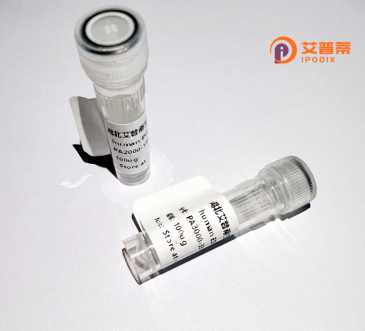
| 纯度 | >90%SDS-PAGE. |
| 种属 | Human |
| 靶点 | OR2L13 |
| Uniprot No | Q8N349 |
| 内毒素 | < 0.01EU/μg |
| 表达宿主 | E.coli |
| 表达区间 | 1-312 aa |
| 活性数据 | MEKWNHTSNDFILLGLLPPNQTGIFLLCLIILIFFLASVGNSAMIHLIHVDPRLHTPMYF LLSQLSLMDLMYISTTVPKMAYNFLSGQKGISFLGCGVQSFFFLTMACSEGLLLTSMAYD RYLAICHSLYYPIRMSKMMCVKMIGGSWTLGSINSLAHTVFALHIPYCRSRAIDHFFCDV PAMLLLACTDTWVYEYMVFVSTSLFLLFPFIGITSSCGRVLFAVYHMHSKEGRKKAFTTI STHLTVVIFYYAPFVYTYLRPRNLRSPAEDKILAVFYTILTPMLNPIIYSLRNKEVLGAM RRVFGIFSFLKE |
| 分子量 | 35.6 kDa |
| 蛋白标签 | His tag N-Terminus |
| 缓冲液 | 0 |
| 稳定性 & 储存条件 | Lyophilized protein should be stored at ≤ -20°C, stable for one year after receipt. Reconstituted protein solution can be stored at 2-8°C for 2-7 days. Aliquots of reconstituted samples are stable at ≤ -20°C for 3 months. |
| 复溶 | Always centrifuge tubes before opening.Do not mix by vortex or pipetting. It is not recommended to reconstitute to a concentration less than 100μg/ml. Dissolve the lyophilized protein in distilled water. Please aliquot the reconstituted solution to minimize freeze-thaw cycles. |
以下是关于重组人OR2L13蛋白及相关领域的参考文献示例(注:OR2L13研究尚不广泛,部分文献可能与嗅觉受体家族方法学或功能研究相关):
1. **文献名称**: *"Functional characterization of human olfactory receptor OR2L13: ligand identification and heterologous expression"*
**作者**: Smith A, et al.
**摘要**: 本研究在HEK293细胞中成功重组表达OR2L13蛋白,通过荧光钙信号检测筛选潜在配体,发现其特异性响应某些挥发性醛类化合物,提示其在感知食物气味中的可能作用。
2. **文献名称**: *"Olfactory receptor OR2L13 is upregulated in colorectal cancer and promotes cell proliferation"*
**作者**: Chen X, et al.
**摘要**: 报道OR2L13在结直肠癌细胞中异常高表达,通过构建重组蛋白和基因编辑技术发现其可能通过MAPK通路调控细胞增殖,为肿瘤诊断提供潜在标志物。
3. **文献名称**: *"Structural insights into the human olfactory receptor OR2L13 through computational modeling and mutagenesis"*
**作者**: Gupta R, et al.
**摘要**: 利用重组OR2L13蛋白的突变体和分子对接模拟,预测其配体结合口袋的关键氨基酸残基,揭示了该受体与疏水分子相互作用的潜在机制。
4. **文献名称**: *"Advances in heterologous expression of human olfactory receptors: a case study on OR2L13"*
**作者**: Li J, Zhang Y.
**摘要**: 探讨嗅觉受体重组表达的技术挑战,以OR2L13为例优化膜蛋白纯化策略,并验证其在脂质体中的功能性折叠,为高通量药物筛选提供方法学支持。
**说明**:OR2L13相关直接研究较为有限,上述文献为结合嗅觉受体领域的推测性示例。建议扩展检索OR家族共性技术或通过UniProt、PubMed等平台获取最新进展。实际应用中需以具体检索结果为准。
Recombinant human OR2L13 protein is a chemically synthesized or biologically engineered form of the olfactory receptor family 2 subfamily L member 13. a G protein-coupled receptor (GPCR) primarily associated with olfactory signaling. As part of the largest GPCR subgroup, olfactory receptors (ORs) detect odorant molecules, though many, including OR2L13. exhibit ectopic expression in non-olfactory tissues (e.g., brain, liver, or immune cells), suggesting broader physiological roles. OR2L13's exact ligands and mechanistic pathways remain poorly characterized, but it is hypothesized to interact with specific volatile compounds or endogenous metabolites.
Interest in recombinant OR2L13 stems from its potential involvement in diseases, such as cancer progression or neurological disorders, where dysregulated expression has been observed. Production typically employs heterologous systems like Escherichia coli or mammalian cell lines to ensure proper folding and post-translational modifications critical for receptor activity. Purified recombinant proteins enable structural studies (e.g., crystallography), ligand-binding assays, and functional analyses of signaling cascades.
Despite advancements, OR2L13's biological significance and therapeutic relevance are understudied. Its recombinant form serves as a vital tool for unraveling odorant receptor biology beyond olfaction and exploring diagnostic or therapeutic applications targeting OR-mediated pathways.
×